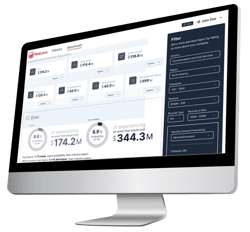 Readers of the RiskLens blog dug into a wide range of topics we published this year, from the basics of FAIR quantitative analysis to revving up a GRC to reporting on risk to the board with our new portfolio capability to…risk of an asteroid crashing into earth (see #7)?
Readers of the RiskLens blog dug into a wide range of topics we published this year, from the basics of FAIR quantitative analysis to revving up a GRC to reporting on risk to the board with our new portfolio capability to…risk of an asteroid crashing into earth (see #7)?
Below is the list of the individual high achievers among the blog posts we published this year. But also relevant are the popular topic clusters that included multiple blog posts. Those leading topics:
 The most blog traffic centered on the My Cyber Risk Benchmark tool introduced this year – and more broadly the insights to be gained from rating your organization’s cyber risk compared to your industry's, based on RiskLens data science research. Read the related blog posts.
The most blog traffic centered on the My Cyber Risk Benchmark tool introduced this year – and more broadly the insights to be gained from rating your organization’s cyber risk compared to your industry's, based on RiskLens data science research. Read the related blog posts. - RiskLens introduced a product suite built around the most common use cases in cyber risk measurement and management, and blog posts and webinars on those topics not surprisingly attracted a lot of attention. Read the related blog posts.
- A series of “Fast Facts” blog posts covered cyber risk statistics for eight industries. Read the related blog posts.
Another topic cluster we are proud to point out: RiskLens received some important recognition for our product leadership in 2022, as detailed in these blog posts:
Most Popular Blog Posts Published in 2022 on the RiskLens Blog, Ranked by Page Views
1. The 7 Types of Cyber Risk Scenarios
The RiskLens data science team crunched the numbers on a vast collection of over nine million cyber risk scenarios covering a huge range of data inputs and analysis outcomes and sorted by industry. They found that virtually all cyber risk scenarios could be grouped into one of seven categories, a finding that informed the design of our My Cyber Risk Benchmark tool.
2. What Is Cyber Risk? The FAIR Definition
This back-to-basics post attracted a lot of traffic, an indicator that the FAIR model for risk quantification keeps getting introduced to a wider audience. By the way, the definition is: “Risk = Probable Frequency and Probable Magnitude of Future Loss.”
3. How Inflation Impacts Cyber Loss Data
 A timely topic as inflation took off late in the year but also insight into the ongoing effort that our data science team puts into updating the risk data that we supply to clients.
A timely topic as inflation took off late in the year but also insight into the ongoing effort that our data science team puts into updating the risk data that we supply to clients.
4. How to Get the Most Out of a GRC with RiskLens Quantitative Risk Analysis
Five ways that RiskLens clients streamline their risk registers by prioritizing risks, aggregating risks by line of business, and more. See a video demo of how the RiskLens platform integrates with GRCs. Also see this blog post: RiskLens Adds New APIs and Export Capabilities for More Integration with Risk Registers and Other Reporting Tools.
5. New from RiskLens, Explain Cyber Risk to the Board and C-suite with Portfolios
Portfolios offer highly flexible, automated reporting with dashboards customizable to the information needs of the board and executive leadership. See a video demo of portfolios.
6. What Is the Magic Cyber Risk Number?
 We often get asked if there’s a single magic number to help communicate information security risk in financial terms, but the beauty of quantitative analysis is the choice of metrics.
We often get asked if there’s a single magic number to help communicate information security risk in financial terms, but the beauty of quantitative analysis is the choice of metrics.
7. Lessons on Reporting Cyber Risk from Netflix’s 'Don’t Look Up'
The film is a comedy about two astronomers trying to warn humankind of a planet-killing comet hurtling toward Earth. But it sounded awfully close to risk analysts or CISOs reporting on cyber risk to executive leadership in an organization that hasn’t made the move to quantitative risk analysis with FAIR.
8. Case Study: Quantitative Risk Assessment for Earthquakes, Strikes and More Operational Risk
It’s a new trend: applying FAIR to all sorts of non-cyber risks. This RiskLens client asked us to analyze earthquake, trucker strike, ransomware, power outage and employee error risk scenarios – with some surprising results.
9. 3 Ways FAIR Cyber Risk Analysis Programs Can Go Wrong (and 3 Simple Fixes)
 After helping some clients get their programs back on track, RiskLens VP-Customer Success Chad Weinman arrived at this insight: small process changes can have a big impact.
After helping some clients get their programs back on track, RiskLens VP-Customer Success Chad Weinman arrived at this insight: small process changes can have a big impact.
10. 5 Uses for a Top Cyber Risks Analysis
Many organizations start their cyber risk quantification (CRQ) program by identifying their top 10-20 cyber and technology risks based on loss exposure in dollars. It’s a quick way to prove the analysis power of the RiskLens CRQ platform and gives direction for cyber risk analysis work going forward. See a video demo of Enterprise Top Risk Reporting with the platform.